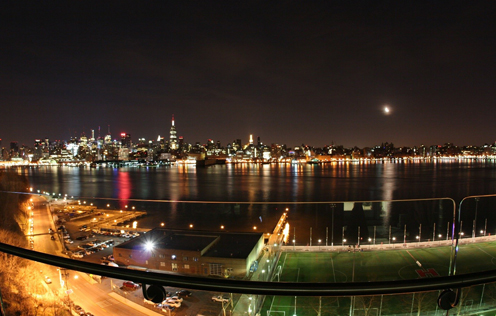During a nine-day period in April 2015, two Aerospace scientists used a sensor originally developed at The Aerospace Corporation to analyze chemicals in the Manhattan air for a CUSP study. CUSP is a leading authority in the emerging field of urban informatics, which uses data collected directly from New York City to better understand how urban cities work. This understanding can help improve a wide range of issues affecting the everyday lives of citizens and the long-term health and efficiency of large cities.
CUSP was interested in what chemical emissions were coming off from Manhattan and gave Aerospace a list of 11 chemicals to search for initially. The field work ultimately uncovered interesting data, including some restricted chemicals, and may result in further collection activities in the future.

Using Infrared Light to See Chemicals
Aerospace’s Dr. Kerry Buckland and Dr. Jun Qian used Aerospace’s GBSS to detect light in the infrared portion of the spectrum. Chemicals in the air absorb specific wavelengths of light, and by determining which wavelengths are being absorbed, it is possible to identify which chemicals are present.
Buckland and Qian set the sensor up in Hoboken, New Jersey, on a sensor platform at the Department of Homeland Security Center of Excellence, operated by The Stevens Institute of Technology. They pointed the sensor across the Hudson River at a part of Manhattan that included the Empire State Building and the Freedom Tower.
Weather permitting, they operated the sensor around the clock, collecting data at intervals ranging from every 5 minutes to every 30 seconds. They observed more than 13,000 regions of interest during that time, and took photos to provide context for the data. The sensor captured images of both small and large chemical emissions and tracked the movement of the chemicals throughout the city.

New York Chemical Emissions Unveiled
The most interesting result Buckland and Qian found in their first round of analysis was large quantities of chlorodifluoromethane, or R-22, coming up from the city. This chemical, a refrigerant that is ozone-depleting and a greenhouse gas, is being phased out under the Montreal Protocol, an international treaty to protect Earth’s ozone layer by eliminating the production of ozone-depleting substances.

From across the Hudson River, the scientists were also able to detect emissions of sulfur dioxide unlawfully released by a passing ship. Ships are supposed to burn clean oil when sailing on the river, but this one was in violation, as demonstrated by Aerospace’s data. The team also detected a variety of other noteworthy chemicals at various locations throughout the city and turned the information over to CUSP for review and assessment.
GBSS Possibilities and Limitations
While they were conducting their research, Buckland and Qian demonstrated to CUSP how the GBSS detected chemicals so accurately and quickly. They had several people stand on a dock across the Hudson River and spray a can of dust cleaner in the air. The sensor instantly detected the chemical—difluoroethane—that was released into the air by the dust cleaner, and was able to follow the chemical wherever the wind took it.
Although the data the Aerospace scientists collected for CUSP was impressive, there were some limitations. Because the GBSS was only directed at the city from the side, it was difficult to tell exactly where a particular chemical was coming from. Despite this one drawback, CUSP recognized that the data the GBSS collected has many potential useful applications and expressed interest in having the scientists conduct further testing by flying an airborne sensor over the city to better pinpoint the locations.
Read the full report here.

